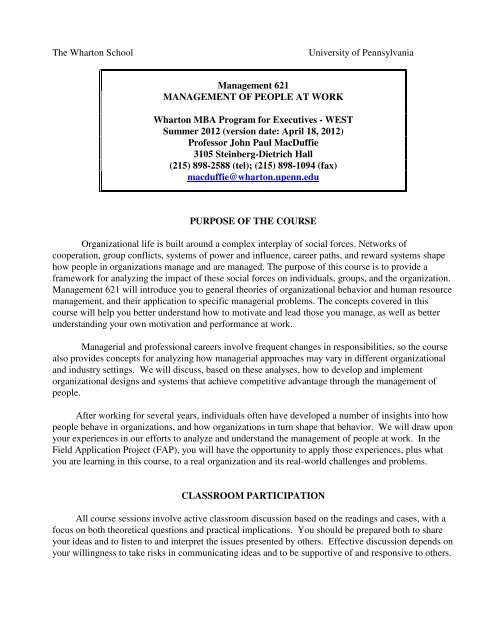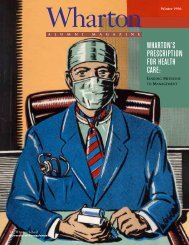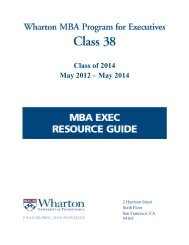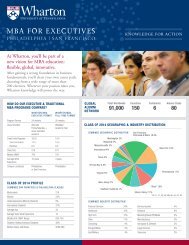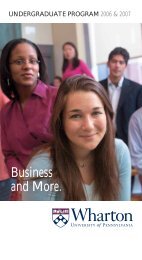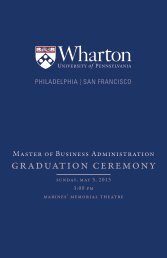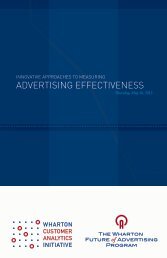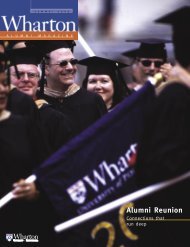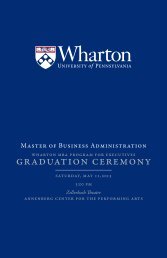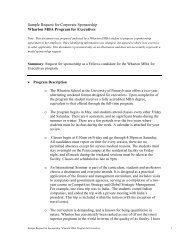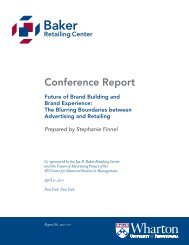version Date: April - The Wharton School of the University of ...
version Date: April - The Wharton School of the University of ...
version Date: April - The Wharton School of the University of ...
You also want an ePaper? Increase the reach of your titles
YUMPU automatically turns print PDFs into web optimized ePapers that Google loves.
<strong>The</strong> <strong>Wharton</strong> <strong>School</strong><br />
<strong>University</strong> <strong>of</strong> Pennsylvania<br />
Management 621<br />
MANAGEMENT OF PEOPLE AT WORK<br />
<strong>Wharton</strong> MBA Program for Executives - WEST<br />
Summer 2012 (<strong>version</strong> date: <strong>April</strong> 18, 2012)<br />
Pr<strong>of</strong>essor John Paul MacDuffie<br />
3105 Steinberg-Dietrich Hall<br />
(215) 898-2588 (tel); (215) 898-1094 (fax)<br />
macduffie@wharton.upenn.edu<br />
PURPOSE OF THE COURSE<br />
Organizational life is built around a complex interplay <strong>of</strong> social forces. Networks <strong>of</strong><br />
cooperation, group conflicts, systems <strong>of</strong> power and influence, career paths, and reward systems shape<br />
how people in organizations manage and are managed. <strong>The</strong> purpose <strong>of</strong> this course is to provide a<br />
framework for analyzing <strong>the</strong> impact <strong>of</strong> <strong>the</strong>se social forces on individuals, groups, and <strong>the</strong> organization.<br />
Management 621 will introduce you to general <strong>the</strong>ories <strong>of</strong> organizational behavior and human resource<br />
management, and <strong>the</strong>ir application to specific managerial problems. <strong>The</strong> concepts covered in this<br />
course will help you better understand how to motivate and lead those you manage, as well as better<br />
understanding your own motivation and performance at work.<br />
Managerial and pr<strong>of</strong>essional careers involve frequent changes in responsibilities, so <strong>the</strong> course<br />
also provides concepts for analyzing how managerial approaches may vary in different organizational<br />
and industry settings. We will discuss, based on <strong>the</strong>se analyses, how to develop and implement<br />
organizational designs and systems that achieve competitive advantage through <strong>the</strong> management <strong>of</strong><br />
people.<br />
After working for several years, individuals <strong>of</strong>ten have developed a number <strong>of</strong> insights into how<br />
people behave in organizations, and how organizations in turn shape that behavior. We will draw upon<br />
your experiences in our efforts to analyze and understand <strong>the</strong> management <strong>of</strong> people at work. In <strong>the</strong><br />
Field Application Project (FAP), you will have <strong>the</strong> opportunity to apply those experiences, plus what<br />
you are learning in this course, to a real organization and its real-world challenges and problems.<br />
CLASSROOM PARTICIPATION<br />
All course sessions involve active classroom discussion based on <strong>the</strong> readings and cases, with a<br />
focus on both <strong>the</strong>oretical questions and practical implications. You should be prepared both to share<br />
your ideas and to listen to and interpret <strong>the</strong> issues presented by o<strong>the</strong>rs. Effective discussion depends on<br />
your willingness to take risks in communicating ideas and to be supportive <strong>of</strong> and responsive to o<strong>the</strong>rs.
Management 621 <strong>The</strong> <strong>Wharton</strong> <strong>School</strong>, <strong>University</strong> <strong>of</strong> Pennsylvania MBAExec (West) – Summer 2012<br />
Regular participation in discussions is expected, and you should carefully prepare <strong>the</strong> readings<br />
and cases for every class session. Individuals are called upon from time to time, but most participation<br />
is voluntary. Name cards must be consistently displayed during class, and it is essential that you attend<br />
all course meetings. Participation counts for 20% <strong>of</strong> your course grade; 15% for individual<br />
participation in class discussion and 5% for your team’s case presentation (see below).<br />
In preparing cases for discussion in class, be ready to comment on (1) <strong>the</strong> case’s background and<br />
context; (2) <strong>the</strong> key issues and problems; (3) concepts useful for analyzing <strong>the</strong> issues and problems;<br />
and (4) a course <strong>of</strong> action for designing and implementing solutions. Questions specific to each case<br />
have been provided in this syllabus to help guide your preparation; however I encourage you to go<br />
beyond <strong>the</strong>se questions in thinking about how to apply any course concepts that are relevant to <strong>the</strong> case.<br />
LEARNING TEAMS AND CASE PRESENTATIONS<br />
Learning teams are integral to <strong>the</strong> work <strong>of</strong> Management 621. Several activities are conducted<br />
through <strong>the</strong> teams, and you may find that preparing for class is facilitated by team discussion. All<br />
participants will be assigned to a learning team by <strong>the</strong> MBAExec program; team assignment is based<br />
on diversity <strong>of</strong> background and experience, subject to physical location constraints.<br />
Each team is assigned to analyze <strong>the</strong> case and readings for one class session. Teams will be<br />
assigned to cases during <strong>the</strong> first week <strong>of</strong> classes. This analysis should explore connections within <strong>the</strong><br />
assigned materials (i.e. how do <strong>the</strong> readings relate to <strong>the</strong> case and vice-versa) and beyond <strong>the</strong> material<br />
to o<strong>the</strong>r experiences, examples, and ways <strong>of</strong> communicating key concepts or insights (i.e. How do <strong>the</strong><br />
readings and/or case relate to <strong>the</strong> past and present experiences <strong>of</strong> any member <strong>of</strong> <strong>the</strong> team Can you<br />
think <strong>of</strong> related and relevant examples from <strong>the</strong> business world, ei<strong>the</strong>r past or present Can you<br />
identify a resource that helps make an important point related to this particular class, e.g. a video, a<br />
song, an image, a literary reference)<br />
<strong>The</strong> assignment requires that you convey your analysis to me and your classmates in two ways:<br />
1. Team paper -- 4-5 pages double-spaced, sent to me by 5 pm on <strong>the</strong> day before <strong>the</strong> class to<br />
which you are assigned<br />
2. Team presentation -- 10 minutes in class in which you present <strong>the</strong> key points from your paper<br />
in a clear, well-organized, compelling, and (if you wish) creative way<br />
This team assignment is worth 5% towards <strong>the</strong> 20% participation grade; as noted above, <strong>the</strong><br />
remaining 15% <strong>of</strong> <strong>the</strong> grade is based on individual participation.<br />
For this team paper, I want <strong>the</strong> members <strong>of</strong> your team to dig into <strong>the</strong> readings and case:<br />
• What intrigues you<br />
• What’s thought-provoking<br />
• What’s important<br />
• What don’t you quite buy, if anything<br />
• What do you think <strong>the</strong> class should note in particular about <strong>the</strong> link between reading and case<br />
• What issues do you think <strong>the</strong> class should grapple with<br />
2
Management 621 <strong>The</strong> <strong>Wharton</strong> <strong>School</strong>, <strong>University</strong> <strong>of</strong> Pennsylvania MBAExec (West) – Summer 2012<br />
I’m looking for thoughtful commentary that reflects your team’s discussions <strong>of</strong> <strong>the</strong> assigned material –<br />
not a summary <strong>of</strong> ei<strong>the</strong>r <strong>the</strong> case or <strong>the</strong> readings and not one person’s solo effort on behalf <strong>of</strong> <strong>the</strong> team.<br />
Do be personal, thoughtful, and analytical. It is fine, and desirable, to use <strong>the</strong> word “we.” Do<br />
suggest video clips, songs, newspaper or business media stories, images, literary references etc. that<br />
help illustrate <strong>the</strong> points you want to make. When I learn about a particularly helpful resource that is<br />
suggested by a team, I will provide access to it (i.e. distribute a copy, post a link, show/play it in class).<br />
For <strong>the</strong> presentation, you have 10 minutes to convey what was included in your paper. (I will run<br />
a timer and cut you <strong>of</strong>f when 10 minutes is up.) You may choose from a variety <strong>of</strong> formats. A<br />
Powerpoint presentation is fine; more than one person should be involved in <strong>the</strong> presentation but<br />
<strong>the</strong>re’s no need for all team members to present. You may also set up a “point and counterpoint”<br />
discussion/debate; dramatize something from <strong>the</strong> case; demonstrate points through a role play; show<br />
different possible future scenarios based on what might happen beyond <strong>the</strong> case; and <strong>the</strong>re are many<br />
o<strong>the</strong>r possibilities. If you have any questions about whe<strong>the</strong>r what you are planning will meet my<br />
expectations and/or my goals for what is learned during <strong>the</strong> class, please ask.<br />
COURSE READINGS<br />
This is a reading-intensive course. All readings are contained in a coursepack, which will be<br />
available on Study.net. You will also receive various handouts throughout <strong>the</strong> course, both in class and<br />
posted on <strong>the</strong> courseware website, Canvas.<br />
SPECIAL TOPIC (NOMINATED BY STUDENTS)<br />
In recent years, I have asked students to suggest a topic related to <strong>the</strong> course that <strong>the</strong>y find to be<br />
important in <strong>the</strong>ir jobs/organizations and want to understand better. We <strong>the</strong>n devote a class session to<br />
this special topic, this year scheduled for Friday, August 3 rd . <strong>The</strong> nomination process begins during <strong>the</strong><br />
first week <strong>of</strong> classes, as a discussion topic on Canvas. I consolidate <strong>the</strong> suggestions into a short list <strong>of</strong><br />
topics and put <strong>the</strong>m to <strong>the</strong> class for a vote. I <strong>the</strong>n develop a supplement to <strong>the</strong> syllabus with readings, a<br />
case, and study questions. <strong>The</strong> special topic in 2010 was Organizational Design and Structure; in 2011,<br />
it was Compensation Within Organizations.<br />
COURSE FEEDBACK CIRCLE<br />
A single feedback circle is formed with three volunteers from each section to review and guide<br />
<strong>the</strong> course work. I will establish <strong>the</strong> schedule <strong>of</strong> meetings during <strong>the</strong> first week <strong>of</strong> class.<br />
“FEET WET”: FIRST WEEK WRITING ASSIGNMENT<br />
I added this assignment after requests to provide some early feedback on your writing and<br />
whe<strong>the</strong>r you are grasping <strong>the</strong> approach to analytical writing I’m seeking in this course. <strong>The</strong> basic idea<br />
is to show that you can link course content (e.g. <strong>the</strong>ories) to a case example (e.g. a specific situation). I<br />
3
Management 621 <strong>The</strong> <strong>Wharton</strong> <strong>School</strong>, <strong>University</strong> <strong>of</strong> Pennsylvania MBAExec (West) – Summer 2012<br />
plan to return <strong>the</strong>se one-page papers with comments but no grade -- just check, check-plus, checkminus<br />
-- and no role in <strong>the</strong> ultimate grading process. This assignment is due in class on Thursday,<br />
May 24; I’ll provide <strong>the</strong> assignment details on Day 1. I’ll also explain o<strong>the</strong>r opportunities for writing<br />
feedback in this course.<br />
COURSE PAPER #1: ANALYSIS OF YOUR CURRENT (OR PREVIOUS) JOB<br />
<strong>The</strong> first graded individual assignment is to analyze your current job (or a previous job) using<br />
course concepts. More precisely, you should use your job as <strong>the</strong> “case” that allows you to apply and<br />
demonstrate your knowledge <strong>of</strong> <strong>the</strong> course material. You may explore such issues as motivation, job<br />
design, reward systems, managing individual and group performance, and group influences on<br />
decision-making. <strong>The</strong> choice about what issues to cover and what concepts to apply is yours. In<br />
evaluating your paper, we will look to see whe<strong>the</strong>r <strong>the</strong> concepts you use are described accurately (i.e.<br />
substantively correct), applied appropriately (i.e. fit <strong>the</strong> job situation you describe), and most relevant<br />
to <strong>the</strong> situation (i.e. did you pick <strong>the</strong> concepts that best illuminates your job situation). This paper will<br />
count for 20% <strong>of</strong> your course grade.<br />
In analyzing your job, focus on how you were managed, not how you behaved in managing<br />
o<strong>the</strong>rs. It does not matter whe<strong>the</strong>r you had a good job experience or a bad job experience. You can<br />
talk about both <strong>the</strong> successful and <strong>the</strong> unsuccessful aspects <strong>of</strong> <strong>the</strong> job, and about what was missing for<br />
you. Very good papers will provide <strong>the</strong> reader with two things: 1) a sense <strong>of</strong> how <strong>the</strong> various issues fit<br />
toge<strong>the</strong>r analytically, and 2) a clear feeling for what it was really like to have that job.<br />
You need to be explicit in your use <strong>of</strong> <strong>the</strong> course <strong>the</strong>ories/concepts. Very good papers do not<br />
simply present a lively and detailed description <strong>of</strong> your past job. Ra<strong>the</strong>r, <strong>the</strong>y demonstrate in-depth<br />
understanding and application <strong>of</strong> course concepts and <strong>the</strong>ories.<br />
Here’s my guidance on how many concepts/<strong>the</strong>ories you should use. More <strong>the</strong>ories can be<br />
better, because you can analyze more aspects <strong>of</strong> your job plus demonstrate more knowledge <strong>of</strong> course<br />
material. Thus a paper that uses more <strong>the</strong>ories and does so effectively can end up with a higher rank in<br />
<strong>the</strong> relative comparison (which is how we grade <strong>the</strong>se papers). However, <strong>the</strong>re are definitely<br />
diminishing returns if you cover lots <strong>of</strong> <strong>the</strong>ories, all <strong>of</strong> <strong>the</strong>m superficially, since this can make it tough<br />
to see if you actually understand <strong>the</strong>m and how to apply <strong>the</strong>m. Plus you need to provide enough rich<br />
descriptive material about your job so we can understand it. So I ask for a minimum <strong>of</strong> three<br />
concepts/<strong>the</strong>ories. One <strong>the</strong>ory is not enough, six is very likely too many. Within that range, we look<br />
for you making wise choices about <strong>the</strong> concepts and <strong>the</strong>ories that best fit your job situation; extra<br />
<strong>the</strong>ories that don’t really fit won’t help you.<br />
In using multiple concepts and <strong>the</strong>ories, you also have <strong>the</strong> opportunity to explore (and<br />
demonstrate your understanding <strong>of</strong>) <strong>the</strong> similarities, complementarities, or inconsistencies among <strong>the</strong><br />
concepts and <strong>the</strong>ories (i.e., do <strong>the</strong> concepts/<strong>the</strong>ories fit toge<strong>the</strong>r and reinforce each o<strong>the</strong>r or do <strong>the</strong>y<br />
disagree How do <strong>the</strong>y complement each o<strong>the</strong>r Conversely, how are <strong>the</strong>y inconsistent or<br />
conflicting). This is not required but is something you can consider doing to streng<strong>the</strong>n your paper,<br />
assuming that your job situation provides you with <strong>the</strong> raw material for this analysis.<br />
Here are a few more words <strong>of</strong> advice based on our past experiences with <strong>the</strong>se papers:<br />
4
Management 621 <strong>The</strong> <strong>Wharton</strong> <strong>School</strong>, <strong>University</strong> <strong>of</strong> Pennsylvania MBAExec (West) – Summer 2012<br />
• Don't forget that this is an exercise that must be graded. It is easy to get carried away with<br />
an interesting story and forget that this is also a way to test your knowledge <strong>of</strong> and ability to<br />
apply <strong>the</strong> course material.<br />
• Be sure to explore your personal experience with your job, ra<strong>the</strong>r than writing generically<br />
about <strong>the</strong> experience <strong>of</strong> all people in positions like yours.<br />
• It may be useful to develop a comparative angle in <strong>the</strong> paper, i.e. compare how your job<br />
experience varied for two different tasks or compare your job before and after a change in<br />
your boss or a company restructuring.<br />
• Remember to mention course <strong>the</strong>ories specifically, so we don’t have to read your mind to<br />
figure out what concepts you are applying to your work experience. Drawing explicit links<br />
between <strong>the</strong> concepts you identify and <strong>the</strong> case material is <strong>the</strong> key. Don't just drop in <strong>the</strong><br />
names <strong>of</strong> a few <strong>the</strong>ories or concepts into <strong>the</strong> midst <strong>of</strong> describing your job. Show how <strong>the</strong>y<br />
apply to your situation.<br />
• Don't simply focus on your favorite issue, or spend a lot <strong>of</strong> time on issues that aren't<br />
relevant to this course.<br />
<strong>The</strong> paper should have a normal font and be double-spaced. <strong>The</strong> maximum length is 1,250 words,<br />
plus or minus 5%. Please include a word count on <strong>the</strong> front page. You will have to be concise and make<br />
choices about what issues to discuss. Formal references or footnotes are not necessary for readings in <strong>the</strong><br />
bulkpack, though be sure to identify a <strong>the</strong>ory or an author explicitly in <strong>the</strong> text. This paper is due via<br />
submission to webCafé by <strong>the</strong> end <strong>of</strong> day on Saturday, June 23rd.<br />
COURSE PAPER #2: INDIVIDUAL CASE ANALYSIS<br />
For <strong>the</strong> second individual assignment, I ask you to submit a written analysis <strong>of</strong> a new case, to be<br />
distributed, along with <strong>the</strong> questions to address, roughly a month before <strong>the</strong> paper is due. As with Paper<br />
#1, I will be looking for <strong>the</strong> application <strong>of</strong> course concepts. <strong>The</strong> maximum length for this case analysis is<br />
1,500 words, plus or minus 5%; it should have a normal-sized font and be double-spaced. Please include<br />
a word count on <strong>the</strong> front page. In view <strong>of</strong> <strong>the</strong> word limit, it is not advisable to summarize case data in<br />
<strong>the</strong> report, but to use data selectively to make specific points. <strong>The</strong> grade will be based on <strong>the</strong> quality <strong>of</strong><br />
<strong>the</strong> ideas, <strong>the</strong> appropriateness <strong>of</strong> <strong>the</strong> concepts chosen, and on how convincingly <strong>the</strong> arguments are made.<br />
This case analysis will count for 20% <strong>of</strong> your grade. It is due via submission to webCafé by <strong>the</strong> end <strong>of</strong><br />
day on Wednesday, July 25.<br />
FIELD APPLICATION PROJECT (FAP)<br />
<strong>The</strong> major group assignment for this course is <strong>the</strong> Field Application Project (FAP), carried out<br />
through learning teams. To guide you through this project, I’ve developed a separate FAP Handbook,<br />
which will distributed to you early in <strong>the</strong> course. I also summarize <strong>the</strong> main elements <strong>of</strong> <strong>the</strong> FAP here.<br />
5
Management 621 <strong>The</strong> <strong>Wharton</strong> <strong>School</strong>, <strong>University</strong> <strong>of</strong> Pennsylvania MBAExec (West) – Summer 2012<br />
<strong>The</strong> focus <strong>of</strong> this project is applying concepts and <strong>the</strong>ories from <strong>the</strong> course to real life<br />
organizational problems in an integrative fashion. You will choose which specific problem to work on,<br />
and in which organization. Most teams choose <strong>the</strong> organization <strong>of</strong> one team member as <strong>the</strong> FAP site,<br />
while o<strong>the</strong>r teams find <strong>the</strong>ir FAP sites through o<strong>the</strong>r organizational connections <strong>of</strong> team members (e.g.<br />
a place where someone volunteers; via a family member.)<br />
We will devote certain class sessions to meetings about FAP between <strong>the</strong> instructor and each<br />
learning team. <strong>The</strong> first meeting, roughly 25 minutes per team, is scheduled for Saturday, June 9.<br />
Teams should plan to develop a one-page summary for <strong>the</strong> FAP that includes a statement <strong>of</strong> <strong>the</strong><br />
problem, <strong>the</strong> planned scope <strong>of</strong> work, and a preliminary approach to exploring <strong>the</strong> problem. This onepage<br />
summary should be e-mailed to me by Wednesday, June 6. <strong>The</strong> second meeting is scheduled<br />
for Saturday, July 21. This will be a progress report, again roughly 25 minutes per team. Please<br />
email a written progress report to me by Wednesday, July 18.<br />
<strong>The</strong> final report for FAP is due on <strong>the</strong> last day <strong>of</strong> class, Saturday, August 4. <strong>The</strong> FAP<br />
reports should be 20 pages long, or roughly 5000 words (word count not needed; appendices not<br />
included in page count). A case format can prove quite valuable, organizing <strong>the</strong> report in multiple<br />
parts, e.g. part 1 that focuses on pure description <strong>of</strong> <strong>the</strong> problem or decision situation, part 2 that<br />
provides your team’s analysis <strong>of</strong> <strong>the</strong> problem; and part 3 that provides your team’s recommendations<br />
for action. Fur<strong>the</strong>r guidance on <strong>the</strong> structure <strong>of</strong> <strong>the</strong> project report will be provided during <strong>the</strong> course.<br />
This report will count for 35% <strong>of</strong> your course grade.<br />
Each learning team will also present its work on FAP to <strong>the</strong> class on <strong>the</strong> last day <strong>of</strong> <strong>the</strong> course.<br />
<strong>The</strong> presentation will count for 5% <strong>of</strong> your course grade. In addition to providing an opportunity to<br />
present ideas before a group <strong>of</strong> peers, this also has <strong>the</strong> advantage <strong>of</strong> sharing <strong>the</strong> learning from your<br />
project. While <strong>the</strong> percentage <strong>of</strong> your grade that depends on your FAP presentation is low, <strong>the</strong> implicit<br />
motivation to do well on <strong>the</strong> presentation is high, in my experience, given <strong>the</strong> natural competitiveness<br />
<strong>of</strong> MBAExec students and <strong>the</strong> feeling <strong>of</strong> pride that team members have about <strong>the</strong>ir FAP work. <strong>The</strong><br />
team should prepare a one page summary <strong>of</strong> <strong>the</strong>ir presentation for distribution to <strong>the</strong> class.<br />
By way <strong>of</strong> illustration, some project titles from <strong>the</strong> past several years are:<br />
• Mind <strong>the</strong> Gap: Confronting Generational Myths among Cisco Employees<br />
• Improving Attraction and Retention <strong>of</strong> Certified Registered Nurse Anes<strong>the</strong>tists<br />
• Black Rock-Barclays Global Investors Merger: Morale and Motivation at Black Rock SF<br />
• Oracle: Managing Developers, Developing Managers<br />
• Glengarry GlenSABIC: <strong>The</strong> New Leads Initiative at Saudi Basic Industries<br />
• Sid’s Hardware: Jayworking on Jay Street<br />
• Implementing Cost Savings in <strong>the</strong> Legal Division <strong>of</strong> Bristol-Myers Squibb<br />
• KLA-Tencor Customer Feature Requests: Climbing Out <strong>of</strong> <strong>the</strong> Black Hole<br />
• BOC Edwards: Motivating Employees During Philadelphia Plant Closure<br />
• Retaining New Mo<strong>the</strong>rs in Demanding Jobs: Fox News, Washington Bureau<br />
• Allegiant Travel: Managing Culture in a Growing Company<br />
• <strong>The</strong> Princeton Review: Cracking <strong>the</strong> Acquisition Test<br />
• Engaging Associates in Times <strong>of</strong> Change at Capital One<br />
• Transitioning to Alternative Legal Fee Structures<br />
6
Management 621 <strong>The</strong> <strong>Wharton</strong> <strong>School</strong>, <strong>University</strong> <strong>of</strong> Pennsylvania MBAExec (West) – Summer 2012<br />
• ERisk: One Team, Many ‘I’s’<br />
• Star Wars: Being SMART on Retention<br />
• Red Door Spas: Short-Term Incentives and <strong>The</strong>ir Effects on Employee Motivation<br />
• Electronic Medical Records: A Clinic’s Long Journey<br />
• Protecting Pandora’s Box: Preserving Organizational Culture in Recruiting and<br />
Performance Management<br />
• Polishing <strong>the</strong> GemStone: Aligning Goals and Incentives in a Virtual Workforce<br />
• Swords into Ploughshares: Integrating Military Veterans at Con Edison<br />
• <strong>The</strong> Merger <strong>of</strong> MedCases and IC Axon: A Tale <strong>of</strong> Two Sales Teams<br />
• Viropharma Inc.: Evaluating Organizational Dynamics Amid Rapid Growth<br />
• Deutsche Bank: Managing <strong>the</strong> Risks <strong>of</strong> a Location Optimization Strategy<br />
• How Can Stocklmeir Elementary Motivate and Retain Teachers<br />
• GE’s Financial Management Program: Doing It Better<br />
• <strong>The</strong> Limited Inc.: Redesigning <strong>the</strong> District Manager’s Role<br />
• Air Products: Implementing Diversity at a Mature Multi-National Company<br />
• Retention <strong>of</strong> Good Technology Employees Inside Motorola<br />
• Attracting and Retaining Millenials: <strong>The</strong> Next Generation at Campbell’s<br />
• Transforming Angel.com into a Customer-Centric Organization<br />
• Clone or Die: Genentech’s Struggle to Reinvent Itself<br />
• <strong>The</strong> Roger Smith Hotel: An Organization at a Cultural Crossroad<br />
• Managing A Biotech across Two Continents: Organizational Challenges at Chemizon<br />
• Patient Safety at Swedish Medical Center: A Call to Action<br />
• Pixar <strong>University</strong>: <strong>The</strong> Force Behind Efficient Employee Utilization<br />
• Connecting <strong>the</strong> Links at AirLink<br />
• <strong>The</strong> Differentiated Workforce at Cypress Semiconductor<br />
• Searching for Innovation at Micros<strong>of</strong>t Online Services Division<br />
• Asian Americans for Community Involvement: Enhancing Organizational Efficiency<br />
EVALUATION<br />
Course evaluation is based on written work and classroom participation, including both<br />
individual contributions and group activities, weighted as follows:<br />
Class participation (including team case presentation)<br />
Course paper – analysis <strong>of</strong> your current job<br />
Individual case analysis<br />
Field Application Project -- written report<br />
Field Application Project -- team presentation<br />
20 percent<br />
20 percent<br />
20 percent<br />
35 percent<br />
5 percent<br />
7
Management 621 <strong>The</strong> <strong>Wharton</strong> <strong>School</strong>, <strong>University</strong> <strong>of</strong> Pennsylvania MBAExec (West) – Summer 2012<br />
SUMMARY OF CLASS SESSIONS<br />
MBAExec WEST -- Summer 2012<br />
Day 1, Session A Introduction to Management <strong>of</strong> People at Work Mon., May 21<br />
Day 1, Session B Motivating Individual Performance Mon., May 21<br />
Day 2, Session A Designing Jobs Wed., May 23<br />
Day 2, Session B Designing Reward Systems Wed., May 23<br />
Day 3, Session A, B Understanding Social Identities (w/Peter Kuril<strong>of</strong>f) Thurs., May 24<br />
Day 4, Session A Recruiting and Selecting Employees Fri., June 8<br />
Day 4, Session B Leadership and Individual Performance Fri., June 8<br />
Day 5, Session A, B First Meeting about FAP project Sat., June 9<br />
Day 6, Session A Driving Group Performance Fri., June 22<br />
Day 6, Session B Decision-Making in Groups and Organizations Fri., June 22<br />
Day 7, Session A Organizing for Productivity and Quality Sat., June 23<br />
Day 7, Session B Organizing for Innovation Sat., June 23<br />
Day 8, Session A Managing a Startup Fri., July 20<br />
Day 8, Session B Creating a High-Performance Culture Fri., July 20<br />
Day 9, Session A,B Second Meeting about FAP project Sat., July 21<br />
Day 10, Session A Special Topic: Nominated by Students Fri., August 3<br />
Day 10, Session B Aligning Human Resources and Business Strategy Fri., August 3<br />
Day 11, Session A, B Presentation <strong>of</strong> FAP Project Sat., August 4<br />
SUMMARY OF COURSE ASSIGNMENT DATES<br />
Thurs., May 24 “Feet wet” writing assignment due in class<br />
Wed., June 6 1-page FAP proposal e-mailed to instructor<br />
Sat., June 9 Team meeting #1 with instructor re: FAP<br />
Sat., June 23 Paper analyzing your job submitted via Canvas<br />
Wed., July 18 FAP progress report e-mailed to instructor<br />
Sat., July 21 Team meeting #2 with instructor re: FAP<br />
Wed., July 25 Individual case analysis submitted via Canvas<br />
Sat., August 4 FAP presentation (1 pg.) & FAP report (20 pgs.)<br />
8
Management 621 <strong>The</strong> <strong>Wharton</strong> <strong>School</strong>, <strong>University</strong> <strong>of</strong> Pennsylvania MBAExec (West) – Summer 2012<br />
TOPICS AND READINGS<br />
Day 1, Session A COURSE INTRODUCTION Mon., May 21<br />
Description: We emphasize <strong>the</strong> central goal for <strong>the</strong> course: to provide students with insights into<br />
<strong>the</strong> complexities <strong>of</strong> human behavior at work and in organizations. We describe <strong>the</strong> sequence <strong>of</strong><br />
topics, from <strong>the</strong> individual level (motivation, job design, equity issues) to <strong>the</strong> group level<br />
(stimulating effective group performance, group decision-making) and <strong>the</strong> organizational level<br />
(culture, organizational design, human resource systems and <strong>the</strong> link to business strategy). We also<br />
review course requirements. <strong>The</strong> readings and case will let us consider key issues confronting<br />
managers <strong>of</strong> people at work, now and in <strong>the</strong> past, to look for similarities and differences.<br />
Readings: Selections (mostly from Fast Company: “Engines <strong>of</strong> Democracy: General Electric”<br />
(October 1999); “Free Agents in <strong>the</strong> Olde World” (May 2001); “Miracle <strong>of</strong> Birth” (October 2002);<br />
“<strong>The</strong> Fabric <strong>of</strong> Creativity” (December 2004); “A Prescription for Innovation” (<strong>April</strong> 2006); “No<br />
Satisfaction at Toyota” (December 2006); “<strong>The</strong> Faces and Voices <strong>of</strong> Google” (March 2008);<br />
Interview with Costco CEO Jim Sinegal (November 2008); “How CAA Plans to Liberate Game<br />
Designers” (<strong>April</strong> 2010); “Hey Rock Stars, Take Your Show Somewhere Else” (January 2011; NY<br />
Times); “Would You Like a Smile with That” (August 2011; NY Times); “KAYAK on Creating a<br />
Culture <strong>of</strong> Innovation” (<strong>April</strong> 2012) Note: <strong>The</strong>se can be sampled and skimmed; <strong>the</strong>y introduce<br />
recent developments in <strong>the</strong> world <strong>of</strong> work that we will consider during <strong>the</strong> course.<br />
Case: <strong>The</strong> Rose Company<br />
1. What is <strong>the</strong> nature <strong>of</strong> <strong>the</strong> change in this company<br />
2. How do <strong>the</strong> vice presidents feel about <strong>the</strong> reorganization<br />
3. What should James Pierce do -- and what will he do<br />
Day 1, Session B MOTIVATING INDIVIDUAL PERFORMANCE Mon., May 21<br />
Description: We begin with an obvious truism about human behavior in organizations -- that<br />
people will behave according to what actions <strong>the</strong>y perceive are being rewarded. We <strong>the</strong>n begin our<br />
exploration <strong>of</strong> <strong>the</strong> <strong>the</strong>me “behavior is not that simple” by pointing out how <strong>of</strong>ten organizations<br />
“reward A while hoping for B”. We also introduce various motivation <strong>the</strong>ories from <strong>the</strong> behavioral<br />
sciences and contrast <strong>the</strong>m with more economics-based views <strong>of</strong> motivation (e.g. agency <strong>the</strong>ory)<br />
which emphasize financial incentives and contract-based goal alignment.<br />
Readings: Steven Kerr, “On <strong>the</strong> Folly <strong>of</strong> Rewarding A While Hoping for B,” Academy <strong>of</strong><br />
Management Executive, Vol. 9, No. 1, pp. 7-14, 1994.<br />
Stephen P. Robbins and Timothy A. Judge, excerpts from “Motivation,” Organizational Behavior,<br />
12 th edition, Englewood Cliffs, N.J.: Prentice Hall, 2007, pp. 192-198, 208-210.<br />
Case: Nordstrom Department Store<br />
1. Who sets <strong>the</strong> performance goals, and how are <strong>the</strong>y set<br />
2. What are <strong>the</strong> major positive and negative effects <strong>of</strong> this incentive system<br />
9
Management 621 <strong>The</strong> <strong>Wharton</strong> <strong>School</strong>, <strong>University</strong> <strong>of</strong> Pennsylvania MBAExec (West) – Summer 2012<br />
Day 2, Session A DESIGNING REWARD SYSTEMS Wed., May 23<br />
Description: Here we focus on <strong>the</strong> design <strong>of</strong> reward systems, keeping in mind various cognitive<br />
processes that affect motivation. We introduce concepts from equity <strong>the</strong>ory, which describes how<br />
individuals assess <strong>the</strong> ratio <strong>of</strong> outcomes (pay, recognition) in relation to inputs (<strong>of</strong> effort, skill,<br />
experience) for <strong>the</strong>mselves in comparison with o<strong>the</strong>rs. We <strong>the</strong>n consider <strong>the</strong> actions (and shifts in<br />
perception) individuals may undertake to establish a sense <strong>of</strong> equity. <strong>The</strong> case discussion<br />
emphasizes how <strong>the</strong> compensation and reward system <strong>of</strong> an organization must balance incentive and<br />
equity concerns. We also explore <strong>the</strong> role <strong>of</strong> <strong>the</strong> labor market in constraining <strong>the</strong> kinds <strong>of</strong><br />
compensation systems firms can implement. Please come prepared with examples <strong>of</strong> reward systems<br />
you have encountered and we will discuss <strong>the</strong>m.<br />
Readings: Elliot Aronson, “<strong>The</strong> Rationalizing Animal,” Psychology Today, May 1973, p. 67-77.<br />
Stephen P. Robbins & Timothy A. Judge, “Equity <strong>The</strong>ory,” from Organizational Behavior, 12 th<br />
edition, Englewood Cliffs, N.J.: Prentice Hall, 2007, pp. 203-207.<br />
Case: Brainard, Bennis, and Farrell<br />
1. How should <strong>the</strong> lawyers listed at <strong>the</strong> back <strong>of</strong> <strong>the</strong> case (A-F) be paid<br />
2. Please meet with your learning team and decide how to apportion 100 points between<br />
<strong>the</strong>m. Come to class ready to present and defend your choice.<br />
Day 2, Session B DESIGNING JOBS Wed., May 23<br />
Description: We next examine job design -- one important source <strong>of</strong> implicit rewards at work. We<br />
teach Hackman and Oldham’s job design <strong>the</strong>ory, which analyzes <strong>the</strong> five dimensions <strong>of</strong> a job that<br />
contribute to its motivational potential. We <strong>the</strong>n explore how poor job design can kill motivation<br />
even when explicit incentives are well-designed – and conversely, how helping someone see <strong>the</strong><br />
connection between <strong>the</strong>ir work and <strong>the</strong> impact on an end-user can be powerfully motivating.<br />
Readings: “Frederick Winslow Taylor: Fa<strong>the</strong>r <strong>of</strong> Scientific Management,” selection from<br />
Business: <strong>The</strong> Ultimate Resource, Cambridge, MA: Perseus Publishing, 2002, pp. 1054-55.<br />
J. Richard Hackman, Greg Oldham, Robert Janson, and Kenneth Purdy, “A New Strategy for Job<br />
Enrichment,” California Management Review, Vol. 17, pp. 57-71.<br />
Adam M. Grant, “How customers can rally your troops: End users can energize your workforce far<br />
better than your managers can,” Harvard Business Review, June 2011: 97-103.<br />
Case: Jennifer Henderson and <strong>the</strong> International Division at Trustworthy Trust<br />
1. Why are analysts such as Henderson demoralized<br />
2. Why do senior managers seem so satisfied<br />
3. What recommendations would you <strong>of</strong>fer <strong>the</strong> Executive Vice President Marshall Wilde<br />
10
Management 621 <strong>The</strong> <strong>Wharton</strong> <strong>School</strong>, <strong>University</strong> <strong>of</strong> Pennsylvania MBAExec (West) – Summer 2012<br />
Day 3, Sessions A, B UNDERSTANDING SOCIAL IDENTITIES Thur., May 24<br />
(with Pr<strong>of</strong>. Peter Kuril<strong>of</strong>f, Graduate <strong>School</strong> <strong>of</strong> Education)<br />
*** “FEET WET” ASSIGNMENT DUE IN CLASS TODAY ***<br />
Readings: Gary Gemmill, “<strong>The</strong> Dynamics <strong>of</strong> Scapegoating in Small Groups,” Small Group<br />
Behavior, vol. 20, no. 4, 1989, pp. 406-418.<br />
Myron Lustig and Jolene Koester, “Cultural Identity, Cultural Biases, and Intercultural Contact,”<br />
chapter 6 in Intercultural Competence: Interpersonal Communication Across Cultures, Boston,<br />
MA: Allyn & Bacon, 2000, pp. 139-173.<br />
Day 4, Session A RECRUITING AND SELECTING EMPLOYEES Fri., June 8<br />
Description: In this class, we turn our attention to employee recruitment and selection. Researchers<br />
have identified a number <strong>of</strong> strategies likely to yield fair, valid, and effective hiring decisions. We<br />
review <strong>the</strong>se strategies and discuss possible reasons why many companies do not put <strong>the</strong>se strategies<br />
into place. We <strong>the</strong>n explore <strong>the</strong> attraction-selection-attrition cycle and <strong>the</strong> implications for<br />
organizational culture and performance. <strong>The</strong> SG Cowen case provides an opportunity to analyze<br />
one company’s recruiting and selection practices; to “select” two <strong>of</strong> <strong>the</strong>ir applicants for hire; and to<br />
examine our assumptions about what makes an effective hire.<br />
Reading: Benjamin Schneider, “<strong>The</strong> People Make <strong>The</strong> Place,” Personnel Psychology, Vol. 40,<br />
1987, pp. 437-53.<br />
Case: SG Cowen: New Recruits<br />
1. Who would you hire and why<br />
2. How will <strong>the</strong> change in recruiting strategy proposed by Chip Rae affect <strong>the</strong> nature <strong>of</strong> <strong>the</strong><br />
company and its culture<br />
3. How would you assess <strong>the</strong> choice between hiring better students at less selective schools vs.<br />
less successful students at more selective schools – what are you getting in each case<br />
Day 4, Session B APPRAISING INDIVIDUAL PERFORMANCE Fri., June 8<br />
Description: We continue on <strong>the</strong> topic <strong>of</strong> individual performance, introducing dilemmas that<br />
managers face with respect to directing, supporting, and evaluating <strong>the</strong> work <strong>of</strong> subordinates:<br />
balancing implicit rewards (challenging work assignments, recognition) with explicit rewards (pay);<br />
weighing incentives for individual achievement vs. incentives for <strong>the</strong> group or team; and handling<br />
performance appraisal in a way that communicates goals and expectations accurately and motivates<br />
improved performance. To guide subordinates towards high individual performance may require<br />
managers to be flexible and adaptive in <strong>the</strong>ir leadership style. <strong>The</strong> case focuses on a situation where<br />
cross-cultural issues also complicate a manager’s choices on <strong>the</strong>se issues.<br />
Reading: John J. Gabarro and Linda A. Hill, “Managing Performance,” Harvard Business <strong>School</strong>,<br />
January, 2002 (9-496-022).<br />
11
Management 621 <strong>The</strong> <strong>Wharton</strong> <strong>School</strong>, <strong>University</strong> <strong>of</strong> Pennsylvania MBAExec (West) – Summer 2012<br />
Case: Karen Leary (A)<br />
1. How would you assess Chung’s performance, and how would you rate Leary’s management<br />
<strong>of</strong> him and <strong>the</strong> <strong>of</strong>fice<br />
2. If you were Chung, how might you have better managed your relationship with Leary<br />
3. If you were Leary, how might you have better managed your relationship with Chung<br />
Day 5, Session A, B MEETING #1 -- FIELD APPLICATION PROJECT Sat., June 9<br />
During this session, I will meet with each learning team to discuss <strong>the</strong>ir ideas for <strong>the</strong> FAP project.<br />
My purpose is mainly to <strong>of</strong>fer suggestions based on my previous experience <strong>of</strong> student groups<br />
working on similar assignments and to provide a sounding board. Teams should plan to develop a<br />
one-page summary proposal for <strong>the</strong> FAP project that includes a statement <strong>of</strong> <strong>the</strong> problem, <strong>the</strong><br />
planned scope <strong>of</strong> work, and a preliminary approach to exploring <strong>the</strong> problem. This one-page<br />
summary should be e-mailed to me by Wednesday, June 6th.<br />
Day 6, Session A DRIVING GROUP PERFORMANCE Fri., June 22<br />
Description: Here we emphasize <strong>the</strong> power <strong>of</strong> group norms and information provided by<br />
coworkers, subordinates, and bosses as influences on individual behavior. <strong>The</strong>se social influences<br />
can, if well-managed, help align group and individual goals with organizational goals, yield higher<br />
performance than individuals provide, especially when tasks are complex and demand<br />
complementary skills, and build a common language and shared experience base to facilitate<br />
coordination and creativity. If poorly managed, however, group norms and information can foster<br />
inappropriate conformity and compliance, diminishing individual, team, or organizational<br />
effectiveness and integrity. We explore both <strong>the</strong> potentially positive and <strong>the</strong> potentially negative<br />
consequences <strong>of</strong> social influence in this class and take a close look at how managers create (and<br />
respond to) groups that are “hot” – lively, high-achieving, dedicated groups, usually small, whose<br />
members are turned on to an exciting and challenging task.<br />
Reading: “Social Influence,” from Thomas Gilovich, Dacher Keltner, and Richard E. Nisbett,<br />
Social Psychology, NYC: WW Norton and Co., 2006, pp. 213-230, 240-253.<br />
Case: Soul <strong>of</strong> a New Machine<br />
1. Why is <strong>the</strong> Eclipse group working so hard<br />
2. In what ways does West give and receive feedback from his group and <strong>the</strong> organization<br />
3. Do you think West’s leadership <strong>of</strong> <strong>the</strong> group is successful in <strong>the</strong> short-run In <strong>the</strong> long-run<br />
What are <strong>the</strong> risks involved in his style<br />
Day 6, Session B DECISION-MAKING IN GROUPS & ORGANIZATIONS Fri., June 22<br />
Description: Group influences in organizations are not always positive. In this class, we consider<br />
situations in which social influences can pull individuals away from alignment with management’s<br />
12
Management 621 <strong>The</strong> <strong>Wharton</strong> <strong>School</strong>, <strong>University</strong> <strong>of</strong> Pennsylvania MBAExec (West) – Summer 2012<br />
goals and result in distorted decision-making dominated by unthinking conformity and compliance<br />
with group biases.<br />
Reading: Irving L. Janis, “Groupthink,” Psychology Today, November 1971, pp. 43-46, 74-76.<br />
In-class exercise: Materials distributed during class<br />
*** JOB ANALYSIS PAPER SUBMITTED VIA WEBCAFE ON SAT., JUNE 23rd ***<br />
Day 7, Session A ORGANIZING FOR PRODUCTIVITY & QUALITY Sat., June 23<br />
Description: We look at <strong>the</strong> organization <strong>of</strong> work and <strong>the</strong> human resource policies associated with<br />
“lean” or “flexible” production (as contrasted with traditional “mass production”) and <strong>the</strong> link to<br />
quality and productivity outcomes (topics you will cover more directly in an OPIM class later this<br />
year.) We teach <strong>the</strong> NUMMI case, emphasizing <strong>the</strong> “people” side <strong>of</strong> <strong>the</strong> production system, e.g.<br />
teams, job rotation, training, standardized work, and o<strong>the</strong>r human resource policies. A key <strong>the</strong>me is<br />
how crucially inter-dependent <strong>the</strong> “people” policies (social system) and manufacturing policies<br />
(technical system) are under lean production. We will also explore how NUMMI, a joint venture<br />
between Toyota and General Motors (recently closed, for reasons we will discuss) approached<br />
changing from a mass to lean production system and <strong>the</strong> cultural change this entailed.<br />
Reading: John Shook, “How to Change a Culture: Lessons From NUMMI,” MIT Sloan<br />
Management Review, Vol. 51, #2, pp. 63-68, 2010.<br />
Ceci Connolly, “Toyota Assembly Line Inspires Improvements at Hospital,” Washington Post, June<br />
3, 2005.<br />
Case: Maryann Keller, “A Tale <strong>of</strong> Two Plants: NUMMI Teamwork vs. GM Bureaucracy,” in Rude<br />
Awakening, (New York: William Morrow, 1989), pp. 125-44.<br />
1. What key decisions did Toyota make in deciding how to manage <strong>the</strong> NUMMI joint<br />
venture plant<br />
2. Why did teams prove to be successful at NUMMI and not at Van Nuys<br />
3. Why has General Motors had so much difficulty learning and diffusing <strong>the</strong> lessons <strong>of</strong><br />
NUMMI to its own operations<br />
Day 7, Session B ORGANIZING FOR INNOVATION Sat., June 23<br />
Discussion: In an era <strong>of</strong> rapid technological change, large, established firms commonly have<br />
difficulty moving as quickly as start-up firms. Hence <strong>the</strong>y <strong>of</strong>ten acquire start-up’s, partly to access<br />
<strong>the</strong>ir innovative products, but even more so <strong>the</strong>ir employees, who possess valuable human capital.<br />
But acquisitions are risky because integrating two firms with different cultures can be very difficult<br />
and <strong>of</strong>ten key employees leave in <strong>the</strong> process. We will examine Cisco Systems, which has become<br />
renowned for its skillful acquisitions <strong>of</strong> small technology companies, its rapid integration <strong>of</strong> human<br />
capital from <strong>the</strong> acquired firms, and <strong>the</strong> relatively low turnover <strong>of</strong> those individuals. We’ll explore<br />
13
Management 621 <strong>The</strong> <strong>Wharton</strong> <strong>School</strong>, <strong>University</strong> <strong>of</strong> Pennsylvania MBAExec (West) – Summer 2012<br />
how Cisco approaches <strong>the</strong> acquisition process from an organizational design and human resource<br />
systems perspective, and consider whe<strong>the</strong>r this strategy for innovation is sustainable over time.<br />
Reading: Peter Cappelli, “A Market-Driven Approach to Retaining Talent,” Harvard Business<br />
Review, January-February 2000, pp. 103-111.<br />
Case: Cisco Systems: Acquiring and Retaining Talent in Hypercompetitive Markets, from Charles<br />
A. O’Reilly III and Jeffrey Pfeffer, Hidden Value: How Great Companies Achieve Extraordinary<br />
Results with Ordinary People, Harvard Business <strong>School</strong> Press, 2000, pp. 49-74.<br />
Plus: Recent articles about Cisco<br />
1. How does Cisco evaluate potential acquisition candidates<br />
2. How does Cisco’s organizational structure facilitate <strong>the</strong> integration <strong>of</strong> acquired firms<br />
3. How do Cisco’s human resources policies facilitate <strong>the</strong> integration <strong>of</strong> acquired firms<br />
4. Can Cisco’s acquisition policies provide a sustained competitive advantage Are <strong>the</strong>y<br />
difficult to imitate<br />
5. How will Cisco need to change its acquisition strategy following <strong>the</strong> dot.bust How<br />
should it pursue innovation under <strong>the</strong>se changed circumstances<br />
Day 8, Session A MANAGING A START-UP Sat., July 20<br />
Description: <strong>The</strong> challenges associated with a start-up company are very different from those <strong>of</strong><br />
managing a long-established firm. Even if acquiring and retaining talented individuals is key to a<br />
start-up’s success, <strong>the</strong> pressing needs <strong>of</strong> establishing <strong>the</strong> business <strong>of</strong>ten push attention to “managing<br />
people” issues to <strong>the</strong> bottom <strong>of</strong> <strong>the</strong> priority list, particularly implementing systematic approaches to<br />
such basic functions as hiring, training, assessing performance, and providing non-financial rewards.<br />
We will use <strong>the</strong> reading about different managerial/cultural “blueprints” found among a sample <strong>of</strong><br />
Silicon Valley start-ups and a case about a recent start-up to examine how entrepreneurs can most<br />
effectively accomplish innovation and sustainable business success through <strong>the</strong>ir management <strong>of</strong><br />
highly skilled human capital. We’ll also explore <strong>the</strong> start-up experiences <strong>of</strong> class members.<br />
Reading: James N. Baron and Michael T. Hannan, “Organizational Blueprints for Success in High-<br />
Tech Start-Ups,” California Management Review, Vol. 44, No. 3, 2002, pp. 8-36.<br />
Case: Automated Travel Systems<br />
Day 8, Session B CREATING A HIGH-PERFORMANCE CULTURE Sat., July 20<br />
Description: Here we explore <strong>the</strong> sources, and consequences, <strong>of</strong> a strong, performance-oriented<br />
organizational culture. <strong>The</strong> readings provide definitions and frameworks for thinking about<br />
organizational culture and point out how difficult culture change can be. <strong>The</strong> case, Mary Kay<br />
Cosmetics, reveals how a strong performance-oriented culture emerges from <strong>the</strong> early choices <strong>of</strong> <strong>the</strong><br />
firm’s founder and is reinforced through <strong>the</strong> skillful use <strong>of</strong> ritual and ceremony. We will discuss <strong>the</strong><br />
14
Management 621 <strong>The</strong> <strong>Wharton</strong> <strong>School</strong>, <strong>University</strong> <strong>of</strong> Pennsylvania MBAExec (West) – Summer 2012<br />
ways in which a manager’s job involves <strong>the</strong> creation and shaping <strong>of</strong> meaning for a firm’s<br />
employees.<br />
Reading: Edgar H. Schein, “Organizational Culture,” American Psychologist, Vol. 45 (2), 1990,<br />
pp. 109-19.<br />
Case: Mary Kay Cosmetics Inc. (and pages 1-7 from Mary Kay Cosmetics: Asian Market Entry)<br />
1. What are <strong>the</strong> artifacts, <strong>the</strong> espoused values, and <strong>the</strong> underlying assumptions <strong>of</strong> <strong>the</strong><br />
culture at Mary Kay Cosmetics<br />
2. How does Mary Kay use ritual and ceremony to create a high-performance culture<br />
What are <strong>the</strong> strengths and weaknesses <strong>of</strong> this approach to achieving performance<br />
Day 9, Session A, B TEAM MEETING #2 -- Sat., July 21<br />
PROGRESS REPORT ON FAP PROJECT<br />
<strong>The</strong> purpose <strong>of</strong> <strong>the</strong>se meetings with learning teams is to get a progress report on <strong>the</strong> projects and do<br />
problem-solving about obstacles that may have arisen at this point. <strong>The</strong> goal is to be sure that teams<br />
are on track to completing <strong>the</strong>ir FAP report and presentation by August 4th. A team progress<br />
report should be emailed to me by Wed., July 18th.<br />
*** CASE ANALYSIS PAPER SUBMITTED VIA WEBCAFE ON WED. JULY 25th ***<br />
Day 10, Session A SPECIAL TOPIC (Nominated by Students) Fri., August 3<br />
Day 10, Session B ALIGNING HUMAN RESOURCES & Fri., August 3<br />
BUSINESS STRATEGY<br />
Description: We highlight both successful and unsuccessful cases in which <strong>the</strong> alignment (or<br />
misalignment) between human resources systems and business strategy is <strong>the</strong> central issue. We also<br />
make clear that <strong>the</strong>re is no “one best way” for all companies in all industries to organize <strong>the</strong>ir<br />
systems for managing people. In <strong>the</strong> case discussion, we try to untangle <strong>the</strong> factors behind <strong>the</strong> early<br />
success and ultimate failure <strong>of</strong> People Express – was it <strong>the</strong> business strategy <strong>the</strong> HR system --<br />
and compare it to <strong>the</strong> current examples <strong>of</strong> Southwest Airlines and JetBlue, successful airlines<br />
following many <strong>of</strong> <strong>the</strong> same HR policies as People Express.<br />
Reading: Jeffrey Pfeffer, “Producing Sustainable Competitive Advantage Through <strong>the</strong> Effective<br />
Management <strong>of</strong> People,” Academy <strong>of</strong> Management Executive, 2005, Vol. 19 (4): pp. 95-106.<br />
Case: People Express (A)<br />
1. What was <strong>the</strong> business strategy, managerial objectives, and assumptions about managing<br />
people underlying <strong>the</strong> design <strong>of</strong> People Express’s human resource system<br />
15
Management 621 <strong>The</strong> <strong>Wharton</strong> <strong>School</strong>, <strong>University</strong> <strong>of</strong> Pennsylvania MBAExec (West) – Summer 2012<br />
2. What are <strong>the</strong> strengths and weaknesses <strong>of</strong> this approach<br />
3. How might <strong>the</strong> firm have achieving a better fit between its strategy and its human<br />
resource system What different strategies would fit with <strong>the</strong> HR system What<br />
different HR systems would fit <strong>the</strong> original strategy<br />
Day 11, Sessions A, B PRESENTATIONS OF FAP PROJECT Sat., August 4<br />
*** FAP PROJECT REPORT DUE TODAY ***<br />
<strong>The</strong> total time allotted to your group presentation will be between 15-20 minutes. Please plan to<br />
spend just half <strong>of</strong> this time on your presentation. Use whatever format and audio-visual tools you<br />
need to communicate <strong>the</strong> key learning from your project most effectively. <strong>The</strong> remaining time is<br />
allocated to taking and responding to questions from <strong>the</strong> audience.<br />
Please have a one-page handout summarizing your presentation for each member <strong>of</strong> <strong>the</strong><br />
audience.<br />
16


